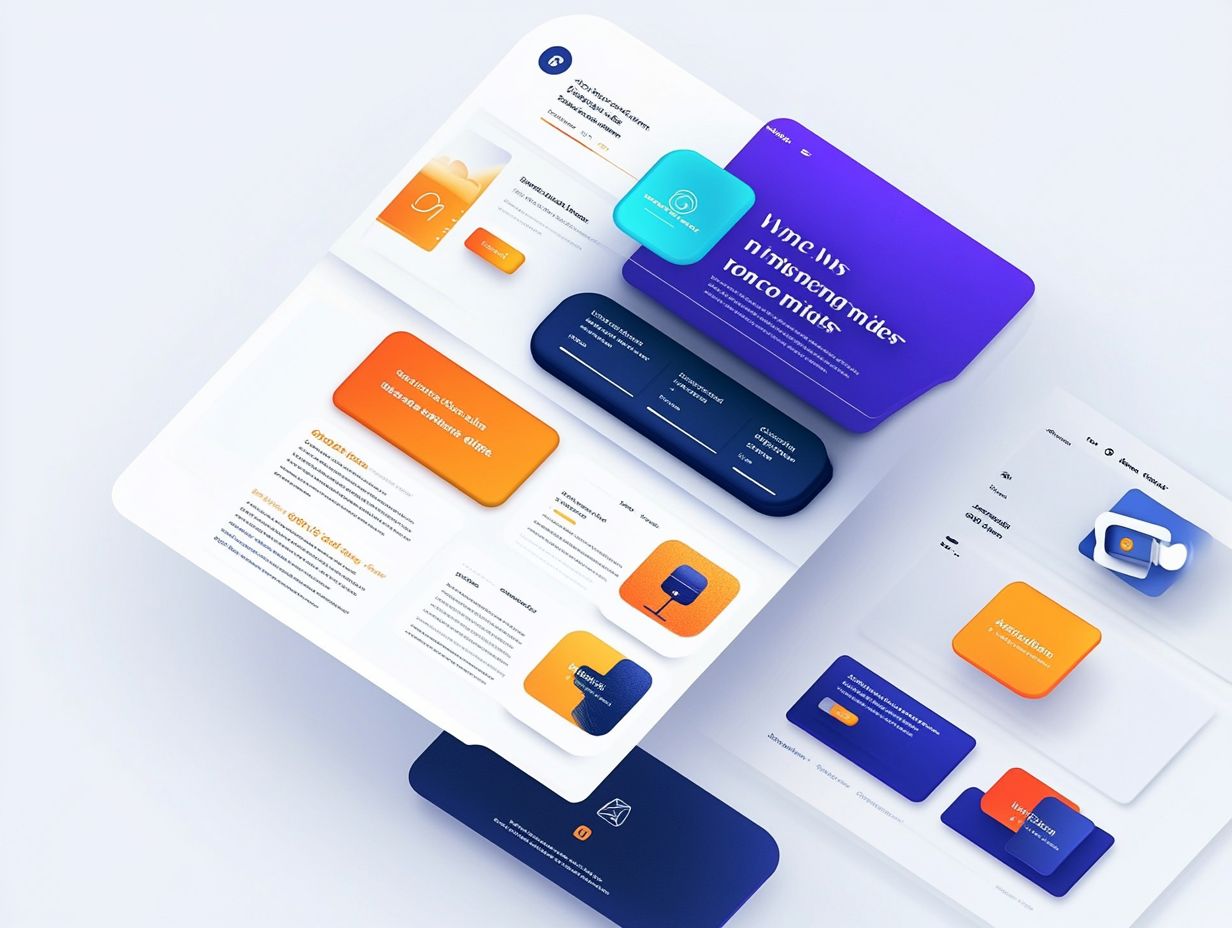How to Create Compelling CTAs for Higher Conversions
In the digital landscape, a well-crafted call-to-action (CTA) can transform a passive visitor into a devoted customer. Understanding the important role CTAs play in driving conversions is essential for marketers.
This article explores effective strategies for creating persuasive CTAs. We’ll cover design best practices, optimization tips for various platforms, and how to measure success while avoiding common pitfalls.
Dive in! Discover how to unlock the full potential of CTAs for your business!
Contents
Key Takeaways:

- A clear, relevant CTA is essential for boosting conversions.
- Use persuasive language to create urgency!
- Regularly track key metrics to measure success and adjust as needed.
The Importance of CTAs
The significance of CTAs (Call to Action) in digital marketing is paramount; they are essential in directing users through the marketing funnel, thereby elevating conversion rates and enriching audience engagement.
Whether it s a straightforward invitation to subscribe to a newsletter or a more enticing proposition to download a free resource, a strategically positioned CTA can profoundly affect customer behavior and enhance lead generation efforts across various platforms, including social media and email marketing.
Understanding the Role of CTAs in Conversions
Understanding the important role of CTAs in conversions is crucial for anyone in digital marketing striving to optimize their copy and enhance user experience.
The effectiveness of Calls to Action (CTAs) can significantly impact conversion rates, transforming casual website visitors into engaged customers. Whether it s a captivating button that beckons users to ‘Subscribe Now’ or a persuasive link inviting them to ‘Learn More’, the right CTAs can effectively guide audience behavior.
Different contexts call for tailored CTAs; for example, e-commerce sites might create a sense of urgency with phrases like ‘Limited Time Offer’, while educational platforms could entice users with ‘Download Our Free Guide’.
By crafting user-centric content that acknowledges the challenges of your target audience, you ensure that these CTAs resonate, maximizing engagement and ultimately boosting conversions.
Effective CTA Strategies
Implementing effective CTA strategies is essential for maximizing audience engagement and ensuring your marketing efforts achieve the desired results. These strategies can greatly improve your impact.
Crafting Persuasive and Relevant CTAs
Crafting persuasive and relevant CTAs requires you to utilize compelling content and actionable copy that directly addresses your users’ needs and challenges while instilling a sense of urgency.
To truly resonate with your audience, it’s crucial to incorporate elements like clarity, ensuring your message is easily understood at a glance. For instance, take a cue from companies like Amazon, which use phrases such as “Only 3 left in stock order soon!” to create a sense of scarcity that compels users to act quickly.
Tailoring your content to align with the specific interests and motivations of your target demographic can significantly boost engagement. A case study involving a nonprofit organization revealed a staggering 40% increase in donations after they refined their CTA to emphasize the direct impact of each contribution on community projects.
These examples highlight the undeniable power of urgency, clarity, and relevance in crafting CTAs that not only inform but also inspire immediate action.
Designing Eye-Catching CTAs

Designing eye-catching CTAs is crucial for capturing your audience’s attention and compelling them to take the desired action whether that’s clicking through to a landing page or engaging with your content on social media.
Best Practices for CTA Design
When designing your CTAs, it s essential to focus on best practices that ensure your messaging is crystal clear, your visuals are captivating, and your user experience is optimized across all devices, especially mobile.
This comprehensive approach guarantees that your call-to-action effectively grabs your audience s attention and encourages them to engage. Key elements, such as contrasting colors, help your CTA stand out, while concise and persuasive language enhances clarity. Mobile optimization is paramount, as a significant number of users access content through their smartphones. Therefore, your buttons should be easily tappable and strategically positioned.
Testing different variations can provide valuable insights into what truly resonates with your users. For example, well-placed CTAs on landing pages have propelled brands like Airbnb to experience a remarkable boost in user engagement, demonstrating that thoughtful design can lead to tangible success.
Optimizing CTAs for Different Platforms
Optimizing your CTAs for different platforms is essential to ensure they resonate with users in diverse contexts. This approach enhances engagement and drives conversions across various channels, including email marketing, social media, and dedicated landing pages.
By tailoring your calls to action to each platform, you create a more compelling experience that encourages users to take the desired steps.
Tailoring CTAs for Websites, Emails, and Social Media
Customizing CTAs for websites, emails, and social media requires understanding each platform’s unique dynamics. In today’s digital world, engaging users is key. A well-placed button on your website inviting visitors to Get Started can boost interaction.
In emails, personalized messages like Unlock Your Exclusive Offer that cater to past behaviors will enhance your outreach. On social media, immediacy is key; CTAs such as Join the Conversation or Swipe Up for More will resonate more with users scrolling through their feeds.
By considering the context and user intent for each platform, you can craft compelling CTAs that not only capture attention but also foster engagement across various channels.
Measuring CTA Success
Measuring how well your CTAs work is vital. It helps you refine your strategies using key metrics, like click-through rates and A/B testing.
By closely monitoring these indicators, you can make informed adjustments that enhance your overall marketing efforts.
Key Metrics to Track for CTA Effectiveness

Key metrics to track for the effectiveness of your CTAs include click-through rates, conversion rates, and user feedback, providing you with valuable insights into user behavior and preferences.
Understanding how each of these metrics correlates with user actions is essential for refining your strategies. For example, click-through rates reveal how compelling your CTAs are, indicating whether users are genuinely enticed to engage with your content.
Similarly, conversion rates reflect the ultimate success of your campaigns, showcasing the percentage of users who take the desired action after interacting with your CTAs. Leading companies like Amazon have harnessed these metrics to optimize their buttons and offers, significantly enhancing user experience and boosting sales.
User feedback plays a crucial role in pinpointing barriers to conversion, allowing you to fine-tune your approach and deliver a more personalized experience.
Common CTA Mistakes to Avoid
Avoiding common CTA mistakes is crucial for ensuring your marketing efforts resonate effectively with your audience. These missteps can obscure your messaging and ultimately diminish conversions.
By focusing on clarity and impact, you position yourself to engage your audience more effectively and drive the results you desire.
Identifying and Fixing Common CTA Errors
Identifying and addressing common CTA errors requires a thoughtful analysis of user feedback and performance data to elevate both your copy and overall user experience.
To tackle this effectively, you’ll want to evaluate key elements such as button color, placement, and wording. Many businesses miss out on testing different options, which can uncover how minor changes can significantly boost conversions.
For example, a popular e-commerce site transformed its CTA from a bland ‘Buy Now’ to the more engaging ‘Grab Your Deal Today!’. This simple change led to a 20% boost in sales.
By carefully checking these components and drawing on real-world examples, you can refine your CTAs, make them resonate with your audience, and ultimately drive superior results.
Frequently Asked Questions
What are CTAs and why are they important for conversions?
CTAs (Call to Actions) are buttons or links that prompt the user to take a desired action, such as signing up for a newsletter or making a purchase. They are crucial for conversions because they guide the user towards a specific goal and create a sense of urgency.
How can I make my CTAs more compelling?

To create compelling CTAs, use action-oriented language that encourages the user to take immediate action. Use persuasive words such as “get started”, “join now”, or “limited time offer”.
Make sure the CTA stands out visually and is easy to locate on the page.
Should I use different CTAs for different pages or goals?
Absolutely! Tailoring your CTAs to the specific page and goal is key. For example, a CTA for a product page may be “Add to Cart,” while a CTA for a blog post may be “Read More.” This ensures that the CTA is relevant and effective for the user’s current journey.
How many CTAs should I include on a page?
It is recommended to use one primary CTA per page to avoid overwhelming the user. However, you can include secondary CTAs that offer additional options or support the primary CTA.
What are some design tips for creating effective CTAs?
Make sure the CTA stands out visually by using contrasting colors, bold fonts, or an eye-catching design. Keep the CTA short and concise, and use a large enough font for easy readability.
Additionally, ensure that the CTA is mobile-friendly for optimal user experience.
Should I test my CTAs?
Yes! Testing two options to see which one works better can help determine which version is more effective in driving conversions. Test different variations of the CTA, such as copy, color, placement, and design, to see which performs better and make necessary adjustments.






